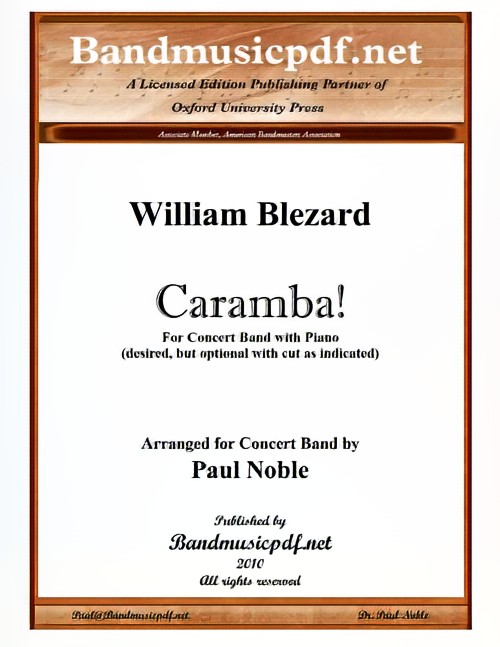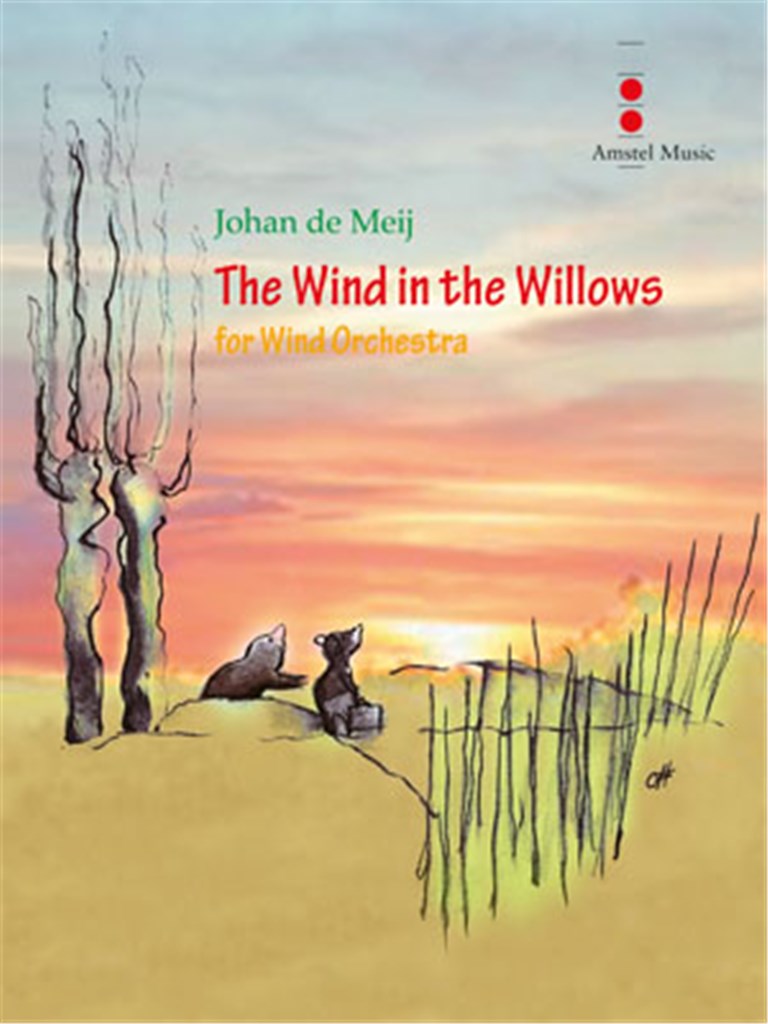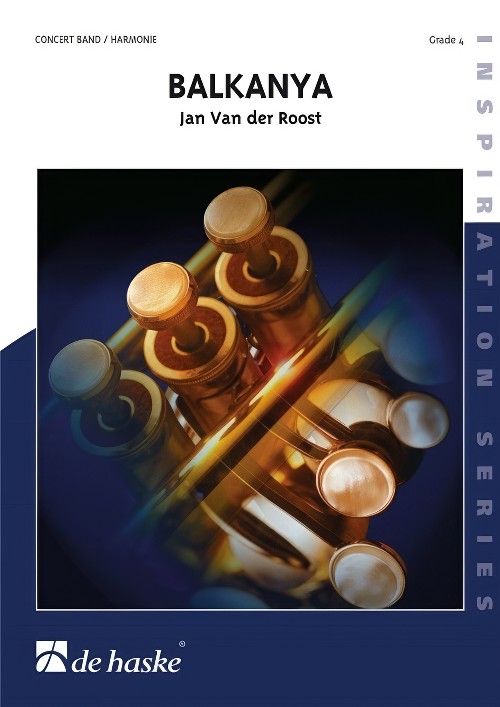Results
-
 £110.00
£110.00Caramba! (Concert Band - Score and Parts) - Blezard, William - Noble, Paul
William Blezard began writing Caramba! during a tour of New Zealand. Yet the musical basis of this work is about as far away from Kiwi culture as one can get. The word Caramba has several translations from the Spanish, including Dear Me!, or Goodness Me!, or perhaps more colloquially, Golly, or even Holy cow!. The entire work has an exotic feel to it that is so suggestive of things Spanish or Latin American. This is helped by the extensive use of percussion, and of course the brass is pure Latin American dance style. The demanding piano part is featured as almost a 'concertante'. In the Concert Band arrangement, the piano is highly desirable to replicate the original score, but the arrangement includes enough doubling and a short cut to make the piece entirely playable without the piano. Caramba! has all the hallmarks of a great piece of concert music that pleases as well as excites. For bands that want a challenge that is sure to bring an audience to its feet, Caramba! is the piece!
Estimated dispatch 7-14 working days
-
 £137.99
£137.99Scaramouche (Euphonium Solo with Concert Band - Score and Parts) - Sparke, Philip
Scaramouche was commissioned by Katrina Marzella with a grant from the BBC Performing Arts Fund.Undoubtedly the finest baritone player of her generation, Katrina was granted an education bursary from the BBC Performing Arts Fund as a result of winning the BBC Radio 2 Young Brass Soloist of the Year in 2004. This has allowed her to commission a series of new works for her instrument, including Scaramouche.In this version for euphonium and concert band, Scaramouche continues Sparke's series of works which uses the Italian improvisational theatre tradition of commedia dell'arte as an inspiration. Pantomime, Harlequin and, now, Scaramouche draw on the contrasting moods of pathos and comedy characterised by the happy/sad masks which symbolise European theatre. A slow expressive ballad, followed by a spirited vivace allows the composer to exploit both the lyrical and technical sides of the euphonium, therefore giving the soloist the chance to display the full capabilities of their instrument.Duration: 7.00
Estimated dispatch 7-14 working days
-
 £154.99
£154.99Arcana (Concert Band - Score and Parts) - Houben, Kevin
Arcana is the plural of the Latin word "arcanum", meaning secret. This substantial work is full of contrasts. Smooth historic like melodies harking back to music of yesteryear, bustling complex rhythms, sections full of energy and beautifully smooth melodic passages. Arcana is a celebration of the brass band and the strength and energy of everyone involved in it. Celebrate the spirit of your own band with this imaginative concert work.Duration: 10:00
Estimated dispatch 7-14 working days
-
 £106.99
£106.99Mandalen Landscapes (Concert Band - Score and Parts) - Sparke, Philip
The picturesque town of Mandalen lies amid snow-covered mountains and scenic fjords on the west coast of Norway. Mndalen Landscapes was commissioned by and written for Mndalen Skule og Ungdomskorps (Mandalen School and Youth Band) for a major concert in November 2003 at the instigation of its conductor, John Hudson, a long-time friend of composer Philip Sparke. Sparke set out to capture the beauty of the area in music and the piece opens with an evocation of the crisp, clear air of a Norwegian morning. After this introduction, the main theme is stated on clarinets and saxophones. A central bridge section takes the listener through several moods until the brass reintroduce the main theme under a woodwind descant. Material from the introduction brings the work to a peaceful close.Duration: 6:00
Estimated dispatch 7-14 working days
-
 £134.99
£134.99Milestone Overture (Concert Band - Score and Parts) - Brosse, Dirk
This work was written at the pivotal point of both two centuries and two millennia. With its hopeful melodies and triumphant parts in the brass section, the opening pictures the dawning of a new era of great expectations, characterized by the high speed of communicating all over the world, which is one of the most important aspects of life in the 21st century. This is achieved by musical themes being rapidly transferred from one musician to another. In this vortex of information and fast business transactions, the sense of individuality threatens to become extinct. At this point, Brosse silences the orchestra (a symbol of society) and draws attention to those people who are less fortunate than most of us. This focus on other people culminates with an orchestral climax in which all powers come together with a feeling of euphoria.Duration: 7:45
Estimated dispatch 7-14 working days
-
 £250.00
£250.00The Wind in the Willows (Concert Band - Score and Parts) - De Meij, Johan
A book for those who keep the spirit of youth alive in them; of life, sunshine, running water, woodlands, dusty roads, winter firesides, said author Kenneth Grahame (1859-1932) about his children's book The Wind in the Willows. Initially, he wrote the stories about Ratty, Mole, Badger and Toad to read to his visually handicapped son Alistair, but after the publication in book form in 1908, it became a worldwide success. It was later also turned into a film and a television series. What appealed ti the composer most is the friendly, very cosy atmosphere that Grahame has managed to create with his optimistic narrative style full of high spirits, an atmosphere that reminds thecomposer of his own carefree youth. It was therefore a great pleasure to set this book to music! The four movements successively describe: I) The River- The river, which flows through the habitat of the animals like a lifeline, regularly is the scene of pleasant boat trips and picnics. The animals lead their untroubled lives here. The four-tone main motif [A-C-D-C] is extensively presented by the brass section, and returns in the following movements as a countermelody. II) Ratty and Mole -The bright, energetic Rat and the melancholy doubter Mole are inseparable friends and have many adventures. Their opposite characters are illustrated by separate musical themes. III) Mister Toad - The wilful, haughty Mister Toad is indeed a unique case: time after time, he runs into tricky situations, and with his indomitable passion for fast, preferably stolen, cars he causes quite a lot of damage... IV) The Return of Ulysses - After Toad Hall, the majestic residence of Mister Toad, is recovered from the weasels and stoats of the Wild Wood, who had captured the estate in a cowardly way, our friends get ready for a banquet. They celebrate the victory with a triumphant parade, and so both the book and the music conclude with a happy ending. Duration: 17.00
Estimated dispatch 7-14 working days
-
 £267.99
£267.99Sinfonietta No.3 (Concert Band - Score and Parts) - Sparke, Philip
In each of the four movements of this major work for concert band, the composer has tried to capture in music something of the spirit of this beautiful Swiss town of Rheinfelden, which lies on the banks of the Rhein. The opening movement, Promenade, sees woodwind and brass alternating short melodic fragments leading to a noble melody from the horns. The dreamy Ballad features a saxophone solo and chorale-like melody. This leads, via a four bar Interlude, to the Scherzo which takes the form of a moto perpetuo.Duration: 18:20
Estimated dispatch 7-14 working days
-
 £59.95
£59.95Scenes From An English Landscape (Concert Band - Score and Parts) - Gorb, Adam
Scenes from an English Landscape is a brief nostalgic tone poem taking its inspiration from visions of rural England as depicted in the paintings of John Constable, the novels of Thomas Hard, and the music of Holst, Gustav and Ralph Vaughan Williams. A chorale-like theme is stated in the brass and then taken up at three times the tempo in the woodwinds. At the end of the work, both versions of the theme are stated together to bring the piece to a triumphant climax.
Estimated dispatch 7-14 working days
-
 £11.95
£11.95Scenes From An English Landscape (Concert Band - Score Only) - Gorb, Adam
Scenes from an English Landscape is a brief nostalgic tone poem taking its inspiration from visions of rural England as depicted in the paintings of John Constable, the novels of Thomas Hard, and the music of Holst, Gustav and Ralph Vaughan Williams. A chorale-like theme is stated in the brass and then taken up at three times the tempo in the woodwinds. At the end of the work, both versions of the theme are stated together to bring the piece to a triumphant climax.
Estimated dispatch 7-14 working days
-
 £154.99
£154.99Balkanya (Concert Band - Score and Parts) - Van der Roost, Jan
Balkanya, a suite in three parts composed by Jan Van der Roost, was commissioned by the Music School of Gaillon - Aubevoye (France) for the celebration of the twentieth anniversary of its creation. Jan Van der Roost dedicated the piece to the director of the school: Thierry Patel. As in his earlier work, Puszta, the composer makes no use of existing dances or themes in these three Balkan dances. This high-spirited suite takes its own approach to the folk music of the Balkan countries and is characterized by unique changes in tempo and spirit. Woodwinds, brass and percussion all have equal parts, making this suite attractive and enjoyable for the entire band.Duration: 10:15
Estimated dispatch 7-14 working days
